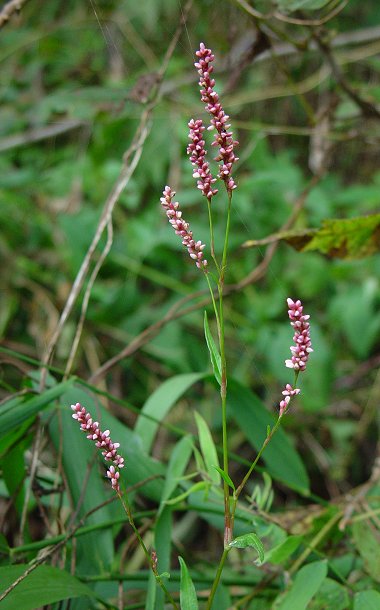Persicaria longiseta (Bruijn) Kitag.
Smartweed

Introduced
CC = *
CW = 3
MOC = 30
© DETenaglia
Persicaria longiseta (Bruijn) Kitag.Smartweed | |
 |
Introduced CC = * CW = 3 MOC = 30 |
© DETenaglia |
|
Family - Polygonaceae Habit - Taprooten annual forb, the stems often also rooting at the lower nodes. Stems - Loosely ascending or spreading with ascending tips, to 50 cm, thin, glabrous, not glandular. Ocreae persistent, usually tearing with age, 5-12 mm long, somewhat inflated toward the base, white to light brown and papery throughout, truncate, not oblique at the tip, lacking a flange of tissue at the tip, the margin with bristles 4-12 mm long, the surface glabrous or appressed-hairy, not glanddotted. Ocreae cilia usually equaling or exceeding main body.
Leaves - Alternate, simple, sessile to short-petiolate. Petioles to 0.6 cm long. Leaf blades 2-8 cm long, 1-3 cm wide, linear-lanceolate to broadly elliptic-lanceolate, angled to tapered at the base, angled or tapered to a sharply pointed tip, the surfaces glabrous or the undersurface appressed-hairy along the main veins, unarmed, lacking impressed glands, the upper surface lacking a darker, chevron- to crescent-shaped area.
Inflorescences - Terminal and axillary clusters from the upper leaves, 1 to several per main stem, 1-4 cm long, 3-7 mm wide, erect or ascending, straight, relatively dense, uninterrupted or occasionally with 1 or a few less-crowded areas, the stalk 1-5 cm long, glabrous, not glandular. Ocreolae mostly overlapping, the surface glabrous, not gland-dotted, the margins with bristles mostly 2.5-3.5 mm long, sometimes exceeding the flowers.
Flowers - Perfect, 4-14 per fascicle, all similar. Perianth 5-parted, pinkish green toward the base, bright reddish pink toward the tip, bell-shaped, not gland-dotted, the tepals 5, 2.2-2.8 mm long, fused below the midpoint, the nerves inconspicuous, irregularly few-branched, not forming a network, not anchor-shaped. Stamens 5, not exserted, the anthers yellow. Styles 3-branched from near the base, not exserted, not persistent.
Fruits - Achenes 1.6-2.5 mm long, 1.1-1.6 mm wide, 3-sided, not exserted, 3-angled, beakless, the faces usually somewhat concave, lacking a central hump, the surface smooth, dark brown to black, shiny. Flowering - May - October. Habitat - Streambanks, bottomland forests, lawns, gardens, railroads, roadsides, moist disturbed areas. Origin - Native Asia. Lookalikes - P. maculosa, P. pensylvanica. Other info. - This is an extremely common species, found in nearly any moist, disturbed area. It is almost startling to realize that Steyermark knew this species only from a few specimens collected in St. Louis, and that the first collections were made in the state in the mid 1950s. Now it is omnipresent, probably occurring in every county of the state. It is grossly undercollected, so its abundance is not adequately documented in herbarium records. Beyond Missouri it is present across the eastern half of the continental U.S. The plant is recognized by its small stature and deep pink inflorescences. It is generally smaller than its lookalikes, and in addition, careful examination of the inflorescence will usually show at least a few "whiskers" (long bristles on the ocreolae) protruding beyond the flowers. The ocreae on the stem are also topped by long bristles. It is uncommon to find more than a few flowers open at one time. Photographs taken along the shores of the Current River, Shannon County, MO., 9-20-03 (DETenaglia); also along the Katy Trail near McKittrick, Montgomery County, MO, 9-17-2020 (SRTurner). |